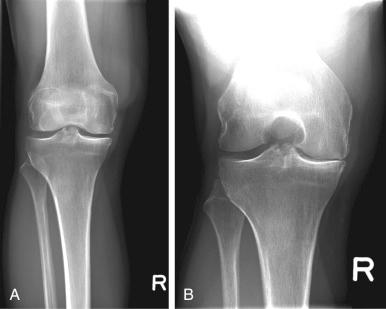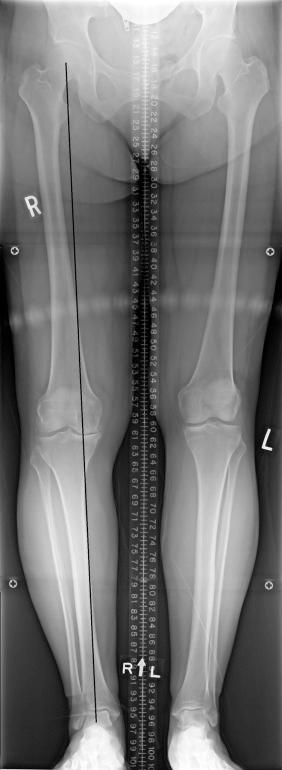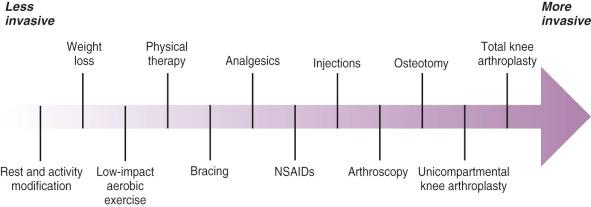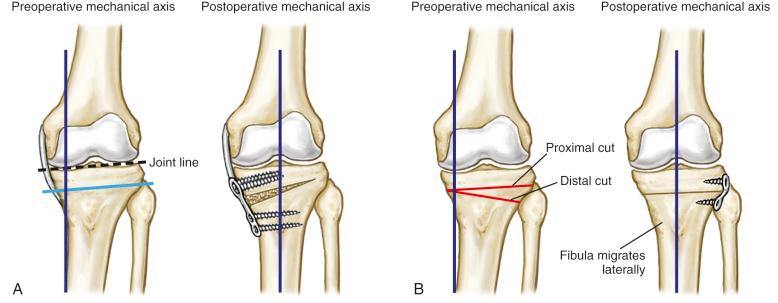Physical Address
304 North Cardinal St.
Dorchester Center, MA 02124
Knee osteoarthritis (OA) is an extremely common cause of disability. The etiology is multifactorial, but joint injury is a prevalent cause of OA in the knee. Studies have shown that meniscal injury requiring a meniscectomy alters knee biomechanics and leads to gonarthrosis. Anterior cruciate ligament (ACL) rupture, a frequently seen and often devastating injury, is characteristically associated with meniscal and chondral injuries. Further deterioration of the joint related to multiple subluxation episodes over time leads to gonarthrosis, which typically affects the medial compartment and results in varus deformity.
A thorough history will rule out systemic causes of pain, such as rheumatoid or other inflammatory arthritides, as well as referred hip pain or radiating pain resulting from degenerative disk disease. Patients with knee OA usually present with pain. Other symptoms include catching, locking, swelling, and decreased motion. Instability is a frequent complaint, but in general it represents quadriceps weakness rather than true ligamentous instability. Patients with chronic ACL deficiency in whom medial compartment gonarthrosis with subsequent varus deformity has developed may experience pain and/or instability. However, in these patients pain is the most common presenting symptom, and instability may not be present as a result of the constraint acquired through the degenerative process and the development of a “cupula” from posteromedial tibial wear. Table 104.1 outlines key questions for patients presenting with knee OA.
| Question | Patient Response |
|---|---|
| Identification | Age, occupation |
| Chief complaint | Pain/clicking/locking/swelling/decreased motion/instability |
| History of presenting illness | Pain history W: Where is most of the pain located? (point with finger) W: When did it start? Q: Quality of the pain; does it radiate? Q: Quantity of pain A: Aggravating factors A: Alleviating factors A: Associated symptoms Associated trauma or injury Mechanism of injury Date Treatment |
| Treatments to date | Analgesics, NSAIDs, bracing, physiotherapy, injections, surgery |
| Functional status | Walking tolerance (no. of blocks) as limited by knee symptoms Sleep disturbance Pain at rest ADLs Sports |
| Expectations | Return to physical work Return to sports and activities Level of competition High-impact versus low-impact activities |
A systematic approach to the physical examination of the knee includes inspection, palpation, range of motion (ROM), and special tests when appropriate. A comparison of the affected and nonaffected limbs, an examination of the joints above and below the affected knee, and an assessment of the patient's distal neurovascular status are routine components of the physical examination.
The inspection begins with an evaluation of limb alignment both while the patient is standing and walking. Varus, valgus, or neutral alignment is noted, as well as an antalgic or Trendelenburg gait or a thrust (i.e., a dynamic change in the deformity with weight bearing). If possible, the patient should perform a full squat and the duck walk (Childress sign). Pain with either or both of these activities suggests a meniscal tear. Any previous incisions should be noted.
With the patient seated and his or her knees flexed over the edge of the table, patellar position and quadriceps asymmetry, if present, are determined. Quadriceps reflex inhibition due to knee injury and effusion frequently leads to quadriceps atrophy.
An effusion, which is characterized by asymmetry in the peripatellar groove on either side of the patella, is confirmed with the swipe test. This test is performed with the patient in the supine position with his or her legs extended and relaxed. The examiner strokes the medial side starting just below the joint line and moves toward the suprapatellar pouch and then does the same on the lateral side while observing for a fluid-wave bulge medially. The presence of a fluid wave indicates a positive swipe test and confirms a small to medium intracapsular effusion.
The patellar ballottement test identifies a moderate to severe effusion. With the knee in full extension, the examiner compresses the patella toward the trochlea and then releases it. If fluid is present, the patella will feel as if it were floating.
Palpation of the knee structures is performed in a methodical fashion and guided by the suspected diagnosis. The temperature of the knee to touch is compared with that of the opposite knee. Increased warmth suggests the presence of inflammation. It is important to determine the point of maximal tenderness. Generally the area anticipated to be most tender is palpated last, so that the patient will not be guarding during the remainder of the examination.
ROM compared with the contralateral knee is measured. Patellar tracking during ROM is palpated, as well as crepitus (a palpable grating sensation) during flexion and extension, with particular attention to its specific location. Finally, the patient is asked to perform a straight leg raise to assess quadriceps strength and extensor mechanism function.
Special tests are then performed, including an assessment of cruciate and collateral stability (see Chapter 90 ). These tests are particularly important to detect the presence of a chronically deficient ACL.
Radiographs taken during weight bearing are the gold standard for imaging any knee condition, especially OA. The standard radiographic knee series includes the following views: bilateral standing anteroposterior (AP), bilateral standing 45-degree posteroanterior (PA) flexion, and lateral and skyline of the affected knee. The specific purpose of the two standing films is to identify joint space narrowing compared with the nonaffected knee.
The weight-bearing 45-degree PA flexion radiograph was first described by Rosenberg et al. in 1988 and is often referred to as the Rosenberg view ( Fig. 104.1 ). The authors noted that some patients for whom no joint space narrowing was visible on standing full-extension AP views often were found to have areas of significant cartilage wear at the time of arthroscopy. As the knee is flexed during the stance phase of gait, the femorotibial contact area moves posteriorly and decreases in size, so that force per unit area loading of the knee is increased. Therefore the flexed knee is much more susceptible to chondral damage and subsequent OA. Furthermore, in patients with ACL deficiency, the altered knee biomechanics lead to increased posteromedial wear, particularly on the tibia. For these reasons, the Rosenberg view has better sensitivity and specificity than the conventional standing AP radiograph in detecting joint space narrowing and OA.

If joint space narrowing is observed on the standard knee series, a standing hip to ankle radiograph should be obtained to assess limb alignment ( Fig. 104.2 ). This view is critical for decision-making and surgical planning. A line from the center of the hip to the center of the ankle defines the mechanical axis in the coronal plane. This line generally passes through the center of the knee in a neutrally aligned limb. Any deviation from this point is considered malalignment. If the line falls toward the medial side of the knee, the limb is in varus alignment; if the line falls toward the lateral side of the knee, the limb is in valgus alignment.

Sagittal plane alignment is determined by measuring the posterior tibial slope. This angle is defined by a line perpendicular to the mid-diaphysis of the tibia and the posterior inclination of the tibial plateau on a lateral radiograph.
Radiographs also identify signs of OA and its severity (e.g., osteophytes, joint space narrowing, subchondral sclerosis, and subchondral cysts), which areas of the knee are affected, limb alignment, posterior tibial slope, patellar height, previous fracture, deformity, and previous surgery as well as previous implants used and the location of the implants.
Magnetic resonance imaging (MRI) is a commonly ordered investigation in patients who present with knee conditions. However, most of the information required for decision-making in patients with knee OA can be gathered from a proper history, physical examination, and the aforementioned radiographs. Bhattacharyya et al. reviewed radiographs and MRI images in 154 patients (men ≥45 years; women ≥50 years) with symptomatic and asymptomatic knee OA. The groups were similar in age. However, patients in the symptomatic OA group had significantly higher body mass index (BMI) scores. The authors found that meniscal tears were highly prevalent in both asymptomatic (76%) and symptomatic (91%) cases of knee OA. Increased radiographic evidence of OA was associated with an increased rate of meniscal tears. No significant difference in pain and function was found on a visual analog scale or the Western Ontario and McMaster Universities Osteoarthritis Index (WOMAC) scores between patients with and without a medial or lateral meniscal tear in the osteoarthritic group. Ultimately the etiology of pain in patients with knee OA is multifactorial and can include cartilage lesions, synovial inflammation, and periarticular muscle strains. The investigators concluded that there is no indication for the routine use of MRI in the evaluation and management of patients with OA of the knee.
Fig. 104.3 shows possible treatment options, from least to most invasive.

The natural history of OA is a waxing and waning course, with days when symptoms are manageable and days when symptoms seem to worsen. Patients should be educated about self-management techniques, including lifestyle and activity modification. Encouraging patients to take responsibility for their condition allows them to actively participate in their care and has been shown to improve symptoms.
Patients with symptomatic knee OA who have a BMI score of more than 25 kg/m 2 should be encouraged to lose weight through diet and exercise. Studies have shown an improvement in overall clinical function in the WOMAC function subscale with weight loss. Other studies have shown that weight reduction decreases the knee joint load per step at a ratio of 1 lb lost to a 4-lb reduction in knee-joint load per step. Weight loss not only has a beneficial effect on the symptoms of knee OA but also provides whole-body health benefits that cannot be overlooked.
Multiple studies have shown that low-impact exercise—such as walking, biking, and using an elliptical trainer—has the beneficial effects of decreasing pain and disability in patients with knee OA. The American Geriatrics Society recommends a minimum of 20 to 30 minutes of physical activity per day two to five times per week for persons with OA.
Patients who have a symptomatic osteoarthritic knee should be encouraged to use acetaminophen for pain relief. Studies comparing the use of acetaminophen (≤4 g/d) with a placebo have shown significant benefit in pain relief without any significant adverse effects. In 2011, the US Food and Drug Administration (FDA) recommended that the dose of acetaminophen be changed to 3 g/day due to the risk of severe liver injury.
Additionally, ketorolac (Tramadol) has been shown to have some benefit in the relief of pain and stiffness and improvement in function in patients with knee OA and may be considered.
In patients who have no risk factors for gastrointestinal disease, nonsteroidal antiinflammatory drugs (NSAIDs) may be prescribed for pain relief. Studies have shown a statistically significant favorable clinical response with the use of NSAIDs versus acetaminophen. Consideration for additional gastroprotective medication along with nonselective NSAID medication or cyclooxygenase-2 inhibitors is recommended. Topical NSAID medication has been shown to improve pain, stiffness, and function and should also be considered.
The use of an unloader knee brace may be a cost-effective adjunct to treatment and a reasonable option to help decrease symptoms and increase function in patients with knee OA. This type of brace functions by helping to transfer the weight-bearing forces from the worn to the unworn part of the knee. Although it can be used for either varus or valgus deformities, it has been primarily studied in patients with medial compartment OA (MCOA). In a study by Kirkley et al., a varus unloader brace was shown to have significant benefit compared with a neoprene sleeve or medical management alone in decreasing pain and improving function. The authors recommended its use in patients with symptomatic unicompartmental OA who have a correctable deformity and an average-sized leg. Also, the use of an unloader brace may help to determine whether the patient will have any benefit from a limb realignment procedure. A further advantage of bracing relates to proprioception. Studies have shown that patients with knee OA have decreased proprioception. Kirkley et al. report that knee braces offer a proprioceptive benefit. The disadvantages to bracing are compliance, difficulty in obtaining a proper fit, and cost.
Quadriceps-strengthening exercises have been shown to provide a significant benefit for symptomatic pain relief. The use of ROM and stretching exercises has not been studied extensively and their clinical effect is unknown. However, flexibility and motion exercises appear to have no adverse effects and offer many health benefits.
Intra-articular corticosteroid injections may be prescribed for the short-term relief of acute pain due to an arthritic “flareup.” Studies have shown that the mean duration of the effect of a corticosteroid injection is 1 week.
Recent studies suggest that there is no benefit to viscosupplementation injections with hyaluronic acid in patients with symptomatic knee OA. A meta-analysis did demonstrate a statistically significant benefit of hyaluronic acid injections with regard to WOMAC pain, stiffness, and function, but these outcomes did not meet the clinically important improvement thresholds. In addition, meta-analysis in meaningfully important difference (MID) units demonstrated a low likelihood of patients achieving clinically important benefits from these injections. Based on these findings, we recommend against the use of hyaluronic acid injections in symptomatic knee OA.
Platelet-rich plasma (PRP) is derived from a patient's own blood. Therapeutic injections of PRP involve concentrating the levels of platelets in the plasma through ultra-high-speed centrifugation. Platelets secrete growth factors and proteins that stimulate tissue healing, and it is believed that this can help to alleviate the symptoms of knee arthritis. At present there is a paucity of evidence supporting the use of PRP in knee arthritis and it should be used with caution.
Mesenchymal stem cells from bone marrow are the most common cells used in stem cell injections for OA. It is believed that these cells have the best potential for developing into cartilage cells that can repair damaged cartilage, decrease the rate of cartilage degeneration, suppress inflammation, and therefore decrease pain. Similar to PRP injections in knee OA, there is little evidence supporting the use of stem cell injections at present and they should be used with caution.
Several treatment options such as glucosamine and/or chondroitin, lateral heel wedges, and needle lavage have historically been prescribed as nonoperative treatment options for patients with symptomatic OA of the knee. However, a sufficient number of high-quality studies have shown that glucosamine hydrochloride and/or chondroitin sulfate have no clinical benefit compared with placebo. Likewise, no good evidence exists to support the prescription of lateral heel wedges for MCOA of the knee. Last, studies recommending needle lavage have been of poor quality, and the procedure has not been shown to have any lasting benefit.
Arthroscopic lavage, débridement, and/or meniscectomy are not recommended in patients whose primary symptom is pain. In 2002 Moseley et al. conducted the first of two randomized controlled studies of the effect of arthroscopic surgery in patients with OA of the knee who presented with knee pain. They compared arthroscopic surgery with arthroscopic lavage and “sham” surgery in 180 patients and found that results of arthroscopic surgery were no better than those of sham surgery at a follow-up of 2 years. In 2008 Kirkley et al. conducted another randomized controlled trial with 188 patients in which arthroscopic surgery was compared with optimized physiotherapy and medical management. These investigators specifically addressed several weaknesses of the study by Moseley et al., which included the use of a nonvalidated outcome measure and the lack of generalizability of their results. This study also showed no difference among the three groups in WOMAC or Short Form (SF)-36 scores at 2 years after surgery. Dervin et al. studied the ability of two groups of surgeons to independently predict the outcome of arthroscopic débridement based on clinical symptoms, signs, and plain radiography. A total of 126 patients were followed for 2 years subsequent to failure of medical management and arthroscopic débridement. Of these, 56 patients (44%) reported a clinically important reduction in pain on the WOMAC pain scale. Furthermore, the investigators found that physicians correctly predicted outcome only 59% or less of the time.
Arthroscopic surgery is not recommended in patients with documented knee OA. Expert opinion suggests that arthroscopy should be considered only in cases where mechanical symptoms rather than pain are the chief complaint.
An osteotomy is a bone realignment procedure for unicompartmental arthritis of the knee. The biomechanical principle of osteotomy is to redistribute the weight-bearing forces from the worn to the unworn compartment of the knee to relieve pain and slow disease progression. The most frequently seen deformity is varus alignment due to MCOA, with isolated lateral compartment OA one-eighth as common as isolated MCOA. The majority of osteotomies are performed on the proximal tibia to treat MCOA. Biopsy and second-look arthroscopic and other open procedures have shown that there is regrowth of fibrocartilage in the worn medial compartment with a predilection for the ulcerated regions of wear in the weight-bearing portion of the medial femoral condyle. Box 104.1 outlines the indications for an osteotomy.
Malalignment + Arthrosis
Malalignment + Instability
Malalignment + Arthrosis + Instability
Malalignment + Meniscal/Cartilage Transplant ± Instability
Both medial opening wedge high tibial osteotomy (HTO) and lateral closing wedge HTO have been used to successfully treat MCOA ( Fig. 104.4 ). The advantages and disadvantages of each technique are outlined in Table 104.2 .

| Advantages | Disadvantages | |
|---|---|---|
| Medial opening wedge | The procedure is technically easier to perform (requiring just one bone cut). It provides the ability to achieve a predictable correction in coronal and sagittal planes. It can be combined with other procedures such as ligamentous reconstruction with relative ease. It restores bone stock. |
Healing in distraction leads to more potential problems with delayed and nonunion. The tibial slope may be difficult to maintain. |
| Lateral closing wedge | Healing in compression leads to fewer problems with delayed and nonunion. It provides favorable alterations in the tibial slope to treat chronic anterior cruciate ligament deficiency. |
The procedure is technically more difficult for inexperienced surgeons.
It decreases bone stock. |
Historically, along with the points shown in Table 104.2 , the concerns with medial opening wedge HTO have been prolonged immobilization and restricted weight bearing, both of which have a significant impact on the patient's quality of life. Recent improvements in implant technology have led to the development of locking plates for HTO. These devices are much stronger than previous nonlocking implants and allow weight bearing as early as 2 weeks after surgery with no loss of correction of the osteotomy and no delayed union or nonunion. Another concern with medial opening wedge HTO is the morbidity associated with the harvesting of iliac crest bone graft required to fill the osteotomy. However, several recent studies have reported that an autograft, an allograft, and even no graft for corrections of 8 mm or less have produced good results, with union occurring by 12 weeks after surgery.
Coventry first described the technique of lateral closing wedge HTO in 1965. Advantages and disadvantages are described in Table 104.2 . Currently our only indication for this procedure is a previous successful lateral closing wedge HTO in the contralateral limb.
Less commonly used tibial osteotomy techniques include the dome osteotomy and external fixation. These techniques are recommended for deformities greater than 25 degrees as well for those that require gradual rather than acute correction, as in skeletally mature patients with Blount disease or in younger patients with idiopathic genu varum.
Become a Clinical Tree membership for Full access and enjoy Unlimited articles
If you are a member. Log in here